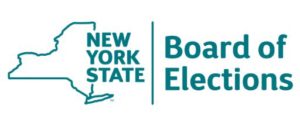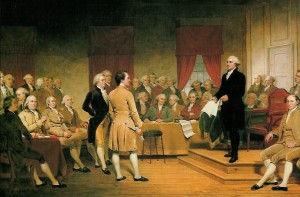
No Campaign On Nov. 7 State ConCon Referendum Raises Three Times More Money Than Yes Campaign
Contact: J.H. (“Jim”) Snider, The New York State Constitutional Convention Clearinghouse
 The first set of campaign finance reports for the committees for and against the Nov. 7, 2017 state constitutional convention referendum were published today, July 17, 2017, by the New York State Board of Elections. The only activity for opponents was reported by New Yorkers Against Corruption with receipts of $635,300.00, expenditures of $246,410.47, and a balance of $323,489.53. All the money was contributed by unions.The only activity for supporters was reported by NY People’s Convention PAC and the Committee for a Constitutional Convention. The NY People’s Convention PAC had receipts of $162,517.19, expenditures of $161,435.17, and a balance of $1,082.02. Virtually all the money was contributed by William Samuels, the principal of NY People’s Convention PAC.
The first set of campaign finance reports for the committees for and against the Nov. 7, 2017 state constitutional convention referendum were published today, July 17, 2017, by the New York State Board of Elections. The only activity for opponents was reported by New Yorkers Against Corruption with receipts of $635,300.00, expenditures of $246,410.47, and a balance of $323,489.53. All the money was contributed by unions.The only activity for supporters was reported by NY People’s Convention PAC and the Committee for a Constitutional Convention. The NY People’s Convention PAC had receipts of $162,517.19, expenditures of $161,435.17, and a balance of $1,082.02. Virtually all the money was contributed by William Samuels, the principal of NY People’s Convention PAC.
The Committee for a Constitutional Convention had receipts of $66,988.86, expenditures of $41,198.74, and a balance of $25,790.12. The money was contributed in relatively small amounts, primarily by individuals expected to run as delegates if the constitutional convention referendum is approved.
The following committees reported no activity: Say No to a Constitutional Convention and Restrict & Regulate in NYState 2019.*
The no campaign thus out-raised the yes campaign by almost 3:1. This is relatively low in comparison to the final ratio in other states, where it is usually above 10:1 (see Snider, J.H., Does the World Really Belong to the Living? The Decline of the Constitutional Convention in New York and Other US States, 1776–2015). Most of the no campaign money is expected to be spent on advertising after Oct. 23, 2017, when the money does not have to be publicly disclosed until after the Nov. 7 referendum. Given the reliance of the yes campaign on funding from William Samuels, the question arises whether he has the motive and means to match yes campaign contributions as the referendum approaches and expenditures increase.
Following the pattern in other states, the no campaign is primarily funded by organizations and the yes campaign by individuals. As a rule, organizations dependent on the legislature’s goodwill don’t want to take a high-profile position supporting an issue that is both of secondary importance to their organizations and that the legislature’s leadership strongly opposes.
The total amount of money spent on a state constitutional convention referendum has in recent decades primarily been highly correlated with polls indicating the likelihood of the referendum passing. When there is a risk of it passing, no campaigns will raise and spend whatever it takes to win. Yes campaigns, in contrast, have not demonstrated the financial capacity to keep up. The highest expenditures occur when the yes campaign is ahead in the polls heading into the last month before a referendum.
The contributions reported to the State Board of Elections should be treated with skepticism. Many types of campaign contributions don’t need to be disclosed, including expenditures on organizational staff and member communications. This gives large-member, wealthy organizations a decided advantage. The timing of contributions also tends to be influenced by strategic decisions, especially whether to wait until the last few weeks before a referendum when reporting can be delayed until after the referendum. Enforcement has also been rare, politically irrelevant, and the cause of lawsuits in other states (e.g., see Snider, J.H., and Beverly Clay, ‘Dark money’ drives R.I. constitutional convention votes, Providence Journal, June 13, 2014; and Snider, J.H., and Beverly Clay, Yes Coalition Files Complaint with Board of Elections; BOE Rules on Complaint, RhodeIslandConCon.info, October 31, 2014). It is almost impossible to verify how much staff time, office space, and other resources are devoted to constitutional convention campaigning in a large organization that pursues many tasks. A notable item of discretion is in-kind contributions. For example, NY People’s Convention PAC reported more than five times the in-kind contributions for office space as New Yorkers Against Corruption. More than one-third of NY People’s Convention PAC’s contributions were in-kind contributions.
###
Addendum
*Restrict & Regulate in NYState 2019 filed a report after the New York State Board of Elections closed at 5:00 pm on July 17, 2017, which resulted in the Board of Elections delaying the posting of the report. Since the report was filed before midnight on July 17 (at 5:01 pm to be exact), it was filed on time. Restrict & Regulate in NYState 2019 reported receipts of $159,967.88, expenditures of $158,405.41, and a balance of $1,562.47. Thus, opponents outraised supporters by approximately 2:1, not 3:1.
Recent Articles on Political Objections to Modernizing Campaign Finance Disclosure
Schneider, Gabriela, U.S. senators are using the equivalent of carrier pigeons to deliver their campaign finance reports, Recode, July 14, 2017.
Wamp, Zach, It Is Time for the U.S. Senate to Join the 21st Century, Morning Consult, July 14, 2017.
